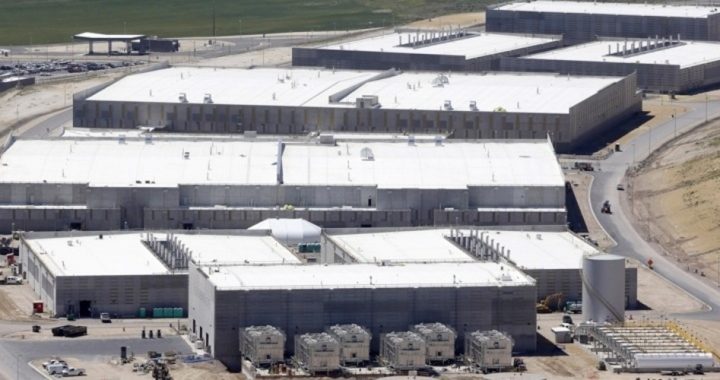
Opening of the highly controversial National Security Agency (NSA) data center in Utah has been delayed after major electrical problems at the facility led to a series of explosions and fires, according to news reports. Official documents suggest there have been at least 10 power surges over the last year, each one costing taxpayers up to $100,000. Still, the problems are apparently not even properly understood yet, let alone close to being fixed.
Known simply as the “Utah Data Center,” the facility (shown) was built to help the out-of-control federal government store the gargantuan amounts of private information the NSA lawlessly vacuums up by spying on the e-mails, Internet activities, phone calls, and other communications of Americans and people around the world. Spanning more than a million square feet and costing taxpayers an estimated $1.7 billion or more so far, the center is reportedly the largest of its kind in the world. Details about the project, including the storage capacity, are mostly classified.
According to the Wall Street Journal, which obtained documents about the electric problems and interviewed sources involved with the project, the Orwellian facility has been plagued by system failures for the last 13 months, preventing the NSA from using the computers and databases. A project official who spoke with the newspaper described the electrical boondoggles, apparently known as “arc fault failures,” as “a flash of lightning inside a 2-foot box.” Among other problems, the surges have led to “fiery explosions,” melting metal, and failing circuits. The most recent episode happened late last month.
Based on documents and comments from sources cited in media reports, it appears that contractors and officials do not really understand the problems, though government spokespeople claim to have a handle on it all. “The failures that occurred during testing have been mitigated,” alleged NSA spokeswoman Vanee Vines in a statement provided to media outlets. “A project of this magnitude requires stringent management, oversight, and testing before the government accepts any building.”
Chief of construction operations Norbert Suter with the Army Corps of Engineers, which is overseeing the project, echoed those comments, claiming that “the cause of the electrical issues was identified by the team, and is currently being corrected by the contractor.” A report produced by Army Corps of Engineers “Tiger Team” special investigators, however, offered a different view: “We did not find any indication that the proposed equipment modification measures will be effective in preventing future incidents.” Apparently the effort to “fast track” the project bypassed normal quality control measures.
Separately, an unnamed person familiar with the database construction offered a more detailed explanation to Forbes. “The problem, and we all know it, is that they put the appliances too close together,” said the source, saying “kill zones” were created by the arcs. “They used wiring that’s not adequate to the task. We all talked about the fact that it wasn’t going to work.”
Of course, when government is involved in anything, failure is typical — or at least poor performance, which is often rewarded with bigger budgets. However, it is no easy task to build and maintain an espionage center that can reportedly store exabytes or even zettabytes of unlawfully obtained data — with an exabyte representing about 100,000 times more data than all the printed material in the Library of Congress, and a zettabyte 1,000 times more than that. According to news reports, the new NSA compound consumes more than 65 megawatts of power per month — enough to power tens of thousands of homes — at a monthly cost to taxpayers of more than $1 million.
Apparently the NSA’s non-stop violations of the rights guaranteed in the Fourth Amendment require a lot of energy elsewhere, too. Its sprawling compound in Ft. Mead, Maryland, for example, reportedly devours as much energy as the city of Annapolis. It was not clear whether the administration’s “green” agenda to drastically limit the energy usage of regular Americans has been foisted on the NSA, but either way, the cost to American taxpayers of being constantly spied on is undoubtedly enormous.
While citizens whose money is being squandered and burned up in Utah may not be pleased to learn about the costly fiascos — let alone how their rights are being violated — commentators have found both humor and irony in the recent meltdowns. “The NSA is basically using so much power in its spying efforts that it is poetically killing its data centers,” remarked Casey Chan at the technology-oriented Gizmodo site.
Others compared the expensive boondoggles to ongoing turmoil with the rollout of ObamaCare, which has been plagued with major failures since before the “healthcare exchanges” even began opening this month. On Twitter, posters blasted and ridiculed the NSA for incompetence, with some analysts suggesting that if NSA spying is anything like its data center, Americans concerned about their privacy do not have much to worry about.
More than a few tech commentators, meanwhile, were upset about the squandering of public funds. “Delivering power to the IT load equipment is one of the fundamental design and construction issues when you build a datacenter,” fumed David Chernicoff with ZDNet, calling the NSA facility a ticking time bomb. “To have electrical faults on this scale is unconscionable, not only in a government project, where they suffer from the ‘other people’s money’ issue, but in any datacenter design.”
The technical fiascos surrounding the NSA scheme in Bluffdale come in the wake of global outrage surrounding a much more serious matter: The agency’s lawless espionage activities, parts of which were exposed this year by former NSA contractor Edward Snowden. The data center was set to be opened just months after the whistleblower, or leaker, depending on one’s point of view, confirmed to the world that the rogue agency was indeed spying on virtually everyone, including you, and keeping the unlawfully collected data for future use and analysis. Many astute Americans already assumed that to be the case based on vast amounts of other evidence, but Snowden’s leaks brought widespread attention to the scandal.
Among the most alarming revelations offered by Snowden was news that the NSA has apparently been targeting for special scrutiny journalists who criticize the federal government’s increasingly lawless activities. Other troubling developments have become so controversial that forces on both sides of the political spectrum — from the liberal ACLU to the conservative NRA — have teamed up in an effort to stop the government’s warrantless and unconstitutional surveillance.
Even before Snowden dropped the bombshell and sparked a global uproar, however, news reports were suggesting that the Utah Data Center would be used to lawlessly house unimaginably vast amounts of information on Americans and foreigners alike. According to a report early last year by The New American’s Tom Eddlem, citing Wired magazine, the NSA planned to use the facility to store everything from “the complete contents of private emails, cellphone calls, and Google searches” to “parking receipts, travel itineraries, bookstore purchases, and other digital ‘pocket litter.’” In other words: everything about you.
An NSA spokesperson confirmed that the facility in Utah is “one of the U.S. Defense Department’s largest ongoing construction projects in the continental United States.” As far as what will go on there, though, the agency has been largely quiet. “This Intelligence Community facility will host the power, space, cooling, and communications needed to support specialized computing,” the spokesperson said, noting that the shadowy compound sits on about 247 acres and includes 1.2 million square feet of enclosed space.
While some analysts have jokingly celebrated the ongoing technical difficulties because they might make it harder for the NSA to spy on Americans for the time being, the warrantless gathering of unfathomably vast amounts of private information on innocent people is no joking matter. The power inherent in having that much private data — imagine, for example, a rogue leader coming to power and being able to blackmail members of Congress or Supreme Court justices — is mind-boggling. The implications could be terrifying. Already, the government has identified pro-lifers, conservatives, libertarians, environmentalists, and others as potential terrorists.
The U.S. Constitution is clear: People have a God-given right to be free from unreasonable searches and seizures, and a lawful warrant must be acquired to spy on citizens. Rather than allowing the NSA to burn through the Bill of Rights and ever greater quantities of taxpayer money to get its lawless espionage facility fixed, Congress ought to rein in the agency and stop its wanton violations and abuses of Americans’ unalienable rights.
Photo of NSA’s Utah data center: AP Images
Alex Newman is a correspondent for The New American, covering economics, politics, and more. He can be reached at [email protected].
Related articles:
NSA Surveillance Covers 75 Percent of Internet Traffic, WSJ Reports
The NSA Domestic Surveillance Lie
NSA Building Largest Spy Center Ever
Suspicions Growing Over Death of Journalist Probing NSA and CIA Abuses
NSA Revelations Prove Abuse Is the Rule, Not the Exception
NRA Files Brief Supporting ACLU Suit Challenging NSA Surveillance
Snowden Says NSA Targets Journalists Critical of Government
Hearing Shows Feds Think Americans Have No Privacy Rights (Video)



